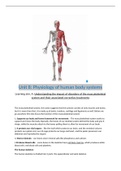Unit 8: Physiology of human body systems
Learning aim, A: Understanding the impact of disorders of the musculoskeletal
system and their associated corrective treatments
The musculoskeletal system, this name suggests that this system consists of only muscles and bones,
but it is more than that, it is made up of joints, tendons, cartilage and ligaments as well. Before we
go anywhere first lets discus the function of the musculoskeletal system
1, Supports our body and forms framework for movement: - The musculoskeletal system works to
support and move the body. Basically, the bones of our skeletal system defend the body and give it
shape, while the muscles attach to the bones pulling them to allow for movement of our body.
2, It protects our vital organs: - like the skull which protects our brain, and the vertebral column
protects our spinal cord, our rib cage protects our lungs and heart, and the pelvis preservers our
abdomen and reproductive organs
3, Stores minerals: - our bones store mineral salts like phosphorus and calcium.
4 Produces blood cells: - some bones in the skeleton have red bone marrow, which produces white
blood cells, red blood cells and platelets.
The human skeleton
The human skeleton is divided into 2 parts: the appendicular and axial skeleton.
,The axial skeleton consists of 80 bones.
Our skull that protects the brain and supports facial structure.
Our vertebral column that surrounds and preserves the spinal cord and supports the head.
Our rib cage that surrounds and protects the organs within the chest (lungs and heart)
The appendicular skeleton consists of 126 bones.
Our pectoral gridle which are the shoulders.
Upper and lower limbs which are arms and legs
The pelvic gridle which are our hip bones
Types of bones
, A normal adult human has 206 bones in the body. And all of these bones have a name or division. A
bone is a connective tissue, this means they function on making a structural framework and they
connect different types of the body.
Long bones form the limbs, which have some of the longest bones in our bodies, these are cylinders
of hard bones with soft spongy marrow inside. They have a body that’s taller in length than its width,
having a hard outer surface of a tight and solid bones. This gives extra solidity at the joint where the
bone articulates with another one.
Short bones are defined of having approximately the same width and length and have a main job of
providing support and stability with little movement. For example, in your wrist and ankle, have the
same structure as long bones but are squat. This gives a greater variety of movement with no loss of
strength. Short bones consist of only thin layer of tight and solid bones.
Flat bones are made up of a sandwich of hard bone with spongy layer between. Their main function
is to protect the body’s vital organs. The largest number of red blood cells are formed in flat bones.
Irregular bones are bones in our body that do not fall into any other division, due to their non-
uniform shape. For example, the box shaped vertebrae that form the backbone, sacrum, and the
lower jaw. They mainly consist of cancellous bone, with a thin outer layer of tight and solid bone.




